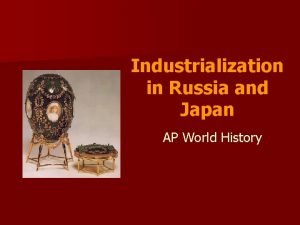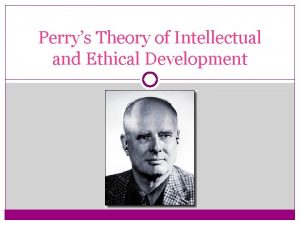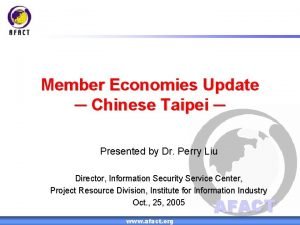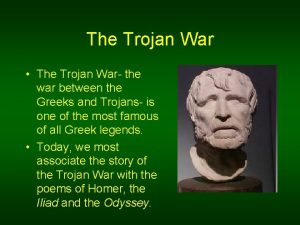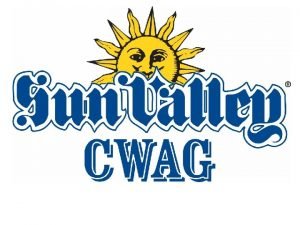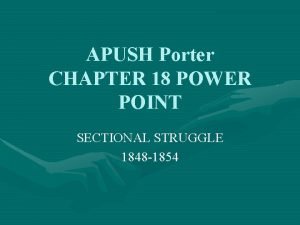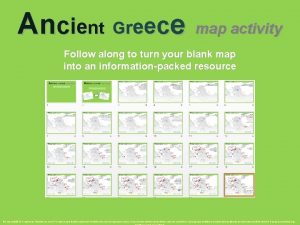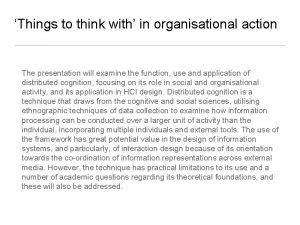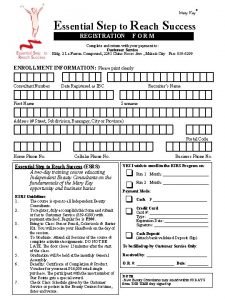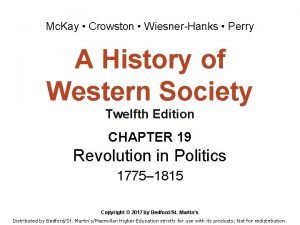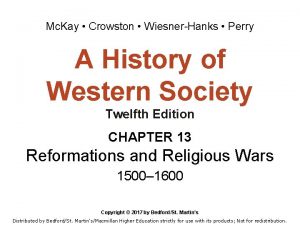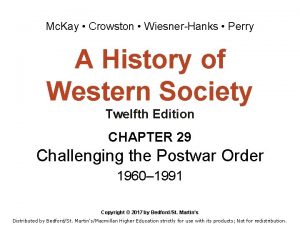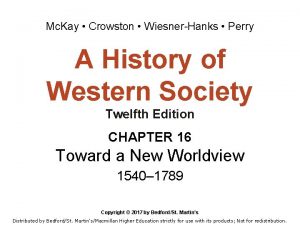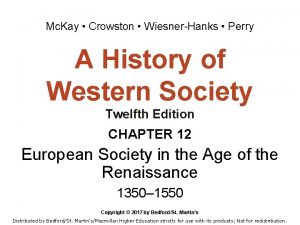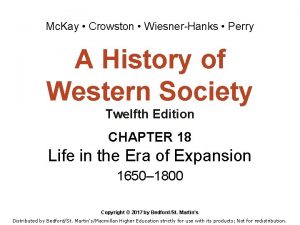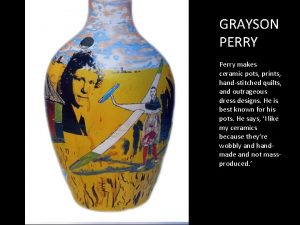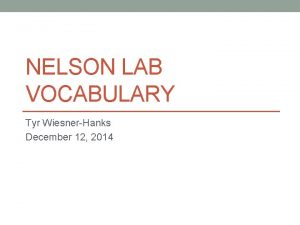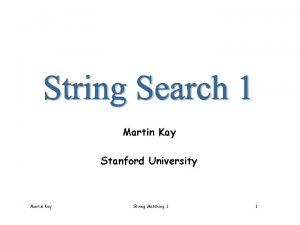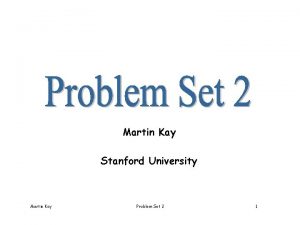Mc Kay Crowston WiesnerHanks Perry A History of












































- Slides: 44

Mc. Kay • Crowston • Wiesner-Hanks • Perry A History of Western Society Twelfth Edition CHAPTER 17 The Expansion of Europe 1650– 1800 Copyright © 2017 by Bedford/St. Martin’s Distributed by Bedford/St. Martin's/Macmillan Higher Education strictly for use with its products; Not for redistribution.


I. Working the Land A. 1. 2. 3. 4. 5. 6. The Legacy of the Open-Field System Open-field system Rotation of crops staggered Communal patterns of farming Heavy taxes and high rents Serfs in hereditary service Better social conditions in western Europe

I. Working the Land B. 1. 2. 3. 4. New Methods of Agriculture New ways of rotating crops More fodder, hay, and vegetables for animals New crops like potatoes and types of beans Enclosure movement

I. Working the Land C. The Leadership of the Low Countries and England 1. Dutch Republic drained marshes for farmland 2. Jethro Tull (1674 – 1741) 3. Selective breeding methods 4. Large-scale enclosure

I. Working the Land C. The Leadership of the Low Countries and England 5. Critics emphasized the resulting social upheaval 6. Market-oriented estate agriculture and proletarianization 7. Widespread unemployment in the countryside


II. The Beginning of the Population Explosion A. Long-Standing Obstacles to Population Growth 1. Irregular cyclical population pattern 2. Food prices rose more rapidly than wages 3. Fertility and mortality rates in balance 4. Famine, disease, and war led to population loss 5. Years of modest growth followed those losses


II. The Beginning of the Population Explosion B. 1. 2. 3. 4. The New Pattern of the Eighteenth Century Dramatic increases in population after 1750 Decline in mortality Disappearance of the bubonic plague Inoculation against smallpox

II. The Beginning of the Population Explosion B. The New Pattern of the Eighteenth Century 5. Improvements in water supply and sewage, drainage of swamps; reduced insect population 6. Better safeguards for food supply 7. Wars less destructive, food supply increased



III. The Growth of Rural Industry A. 1. 2. 3. 4. 5. The Putting-Out System Cottage industry, the “putting-out system” Industries grew in scale and complexity Underemployed labor abundant Rural manufacturing most successful in England Continental countries developed rural industry more slowly


III. The Growth of Rural Industry B. The Lives of Rural Textile Workers 1. Textile industry employed the most people in Europe 2. Handloom weaving 3. Merchants hired wives and daughters to spin 4. Mutual suspicion between workers and employers

III. The Growth of Rural Industry B. 5. 6. 7. The Lives of Rural Textile Workers Lower wages for female workers Low wages to force the “idle” poor to be productive New police powers over workers


III. The Growth of Rural Industry C. 1. 2. 3. The Industrious Revolution Households stepped up the pace of work Rural and urban wage workers Women worked menial, tedious jobs for low wages, but had a greater role in the household 4. Market-produced versus homemade goods

IV. The Debate over Urban Guilds A. 1. 2. 3. 4. 5. 6. Urban Guilds Undermining of the traditional guild system Jean-Baptiste Colbert revived the urban guilds Guilds served social and religious functions Restricted membership to local men Most men and women worked in non-guild trades Some women accepted into guilds


IV. The Debate over Urban Guilds B. 1. 2. 3. Adam Smith and Economic Liberalism Guild critics: outmoded and exclusionary Adam Smith (1723 – 1790) Inquiry into the Nature and Causes of the Wealth of Nations (1776) 4. Criticized guilds for their restrictions

IV. The Debate over Urban Guilds B. 5. 6. 7. Adam Smith and Economic Liberalism Free competition and “division of labor” “Only three duties” for government Pursuit of self-interest in a competitive market

V. The Atlantic World and Global Trade A. 1. 2. 3. 4. Mercantilism and Colonial Competition System of economic regulations First of the Navigation Acts (1651) Form of economic warfare The War of the Spanish Succession

V. The Atlantic World and Global Trade A. 5. 6. 7. 8. Mercantilism and Colonial Competition War of the Austrian Succession (1740 – 1748) The Seven Years’ War (1756 – 1763) Treaty of Paris (1763) British trading and colonial empire


V. The Atlantic World and Global Trade B. 1. 2. 3. 4. 5. 6. The Atlantic Economy Triangular trade Colonial trade 500, 000 slaves in Saint-Domingue by 1789 Spain’s influence expanded westward System of debt peonage Intercolonial trade between the Caribbean and North American colonies






V. The Atlantic World and Global Trade C. 1. 2. 3. The Atlantic Slave Trade Intensified dramatically after 1750 Rise of plantation agriculture Some African merchants gained access to European and colonial goods, like firearms 4. Wars among African states 5. Britain abolished the slave trade in 1807


V. The Atlantic World and Global Trade D. Identities and Communities of the Atlantic World 1. Creoles 2. Unions of European men and indigenous or African women 3. Mixed-race people could rise to the colonial elite 4. Many masters acknowledged and freed their mixed-race children 5. British men forbidden from interracial marriage; left mix-race children in slavery

V. The Atlantic World and Global Trade D. Identities and Communities of the Atlantic World 6. Complex identities and social hierarchies 7. Ambition to convert native peoples to Christianity 8. Large-scale conversion in Central and South America 9. Slavery limited efforts to spread Christianity 10. Jews were eager participants in the new Atlantic economy




V. The Atlantic World and Global Trade E. The Atlantic Enlightenment 1. British North American colonies adopted the Scottish model of the Enlightenment 2. Benjamin Franklin’s writings 3. Reform ideas of educated elites in the Spanish American colonies 4. Enlightenment encouraged colonist to aspire toward greater autonomy


V. The Atlantic World and Global Trade F. 1. 2. 3. 4. 5. 6. 7. Trade and Empire in Asia and the Pacific Dutch controlled East Indian states Lost their hold on Asia in the eighteenth century Britain empire-wide trading priveleges East India Company in Bengal Direct administration by the British government British settlement of Australia Trade in Atlantic inseparable from Asian commerce


 Daimyo definition ap world history
Daimyo definition ap world history Perry’s theory of intellectual and ethical development
Perry’s theory of intellectual and ethical development Balamory painter
Balamory painter Dr perry liu
Dr perry liu Personification in the song roar
Personification in the song roar Brian perry lawyer
Brian perry lawyer Ut tyler scholarships
Ut tyler scholarships Gabby perry
Gabby perry Trojan labor
Trojan labor Perry zinn rowthorn
Perry zinn rowthorn Perry babb
Perry babb Perry glasser
Perry glasser Lee burdette williams medium
Lee burdette williams medium Perry high school marching band
Perry high school marching band Dr richard perry neurologist
Dr richard perry neurologist Kansas nebraska act
Kansas nebraska act Ivan perry
Ivan perry Perry meridian middle school
Perry meridian middle school Kuhn perry
Kuhn perry Perry como sunrise sunset
Perry como sunrise sunset Jason perry rcc
Jason perry rcc Matt thiessen
Matt thiessen Onomatopoeia roar
Onomatopoeia roar Perry grigsby
Perry grigsby Dr. perry sugar
Dr. perry sugar Perry aritua
Perry aritua Perry reece map
Perry reece map First word on the cross
First word on the cross Perry high school marching band
Perry high school marching band Katy perry poem
Katy perry poem Gabby perry harvard
Gabby perry harvard Clarence perry
Clarence perry Vizamyl
Vizamyl Katy perry firework figurative language
Katy perry firework figurative language Mark perry brunel
Mark perry brunel William g. perry
William g. perry Creative commons license
Creative commons license Dr josephine perry swimming
Dr josephine perry swimming Kalani craig
Kalani craig Spay perry county
Spay perry county History also history physical
History also history physical Was robert de la salle married
Was robert de la salle married Oral na dimension
Oral na dimension Kay avila
Kay avila Mary kay esrs training
Mary kay esrs training
